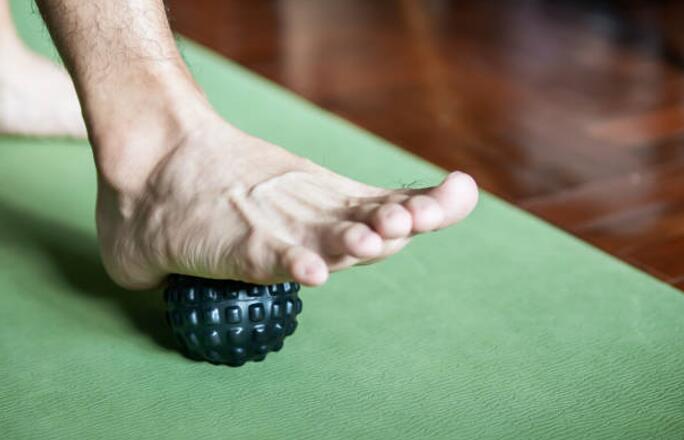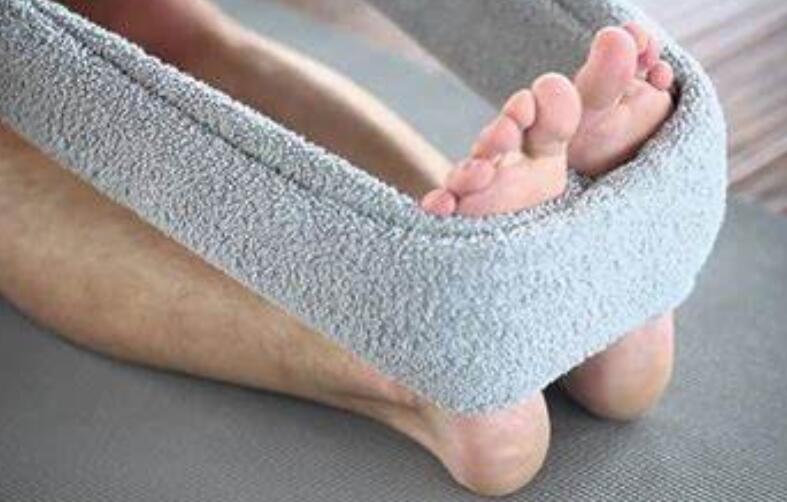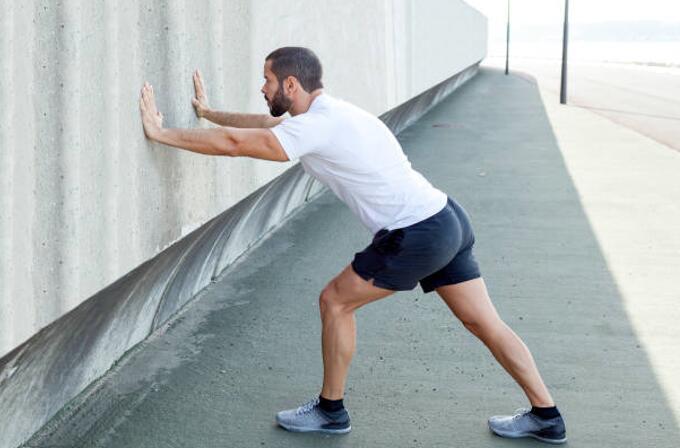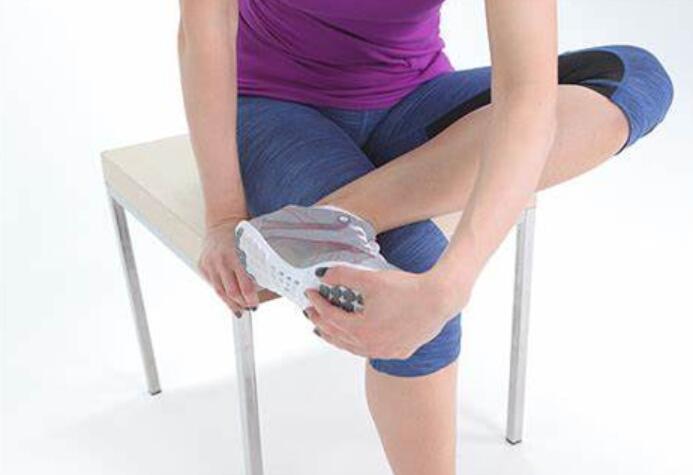Plantar fasciitis is a common condition that causes heel pain. Although it can affect people of all ages, it is more common among runners and people who are always on their feet. The good news is – Your plantar fasciitis usually resolves within 6 to 18 months without treatment. However, you can use several strengthening and stretching exercises to reduce pain and improve walking significantly. This article will discuss the 7 best stretches and exercises for plantar fasciitis at home.

What is the plantar fascia?
The plantar fascia is a thick band of connective tissue located on the sole of the foot. It stretches from the heel bone (calcaneus) to the base of the toes, supporting the foot’s arch.
The plantar fascia is made up of collagen fibers, which give it strength and flexibility. It plays a crucial role in distributing the forces exerted on the foot during movement and helps stabilize the arch.
When the plantar fascia is subjected to excessive stress or repetitive strain, it can become inflamed, resulting in a condition known as plantar fasciitis.
Top 10 Common Causes of Plantar Fasciitis
1. Overuse and Repetitive Activities
Plantar fasciitis often occurs due to overuse or repetitive activities that strain the feet excessively. Engaging in high-impact exercises, such as running or jumping, without proper rest or recovery can lead to micro-tears in the plantar fascia, resulting in inflammation and pain.
2. Foot Structure and Biomechanical Issues
Individuals with flat feet, high arches, or abnormal foot mechanics are more prone to developing plantar fasciitis. These structural irregularities can affect weight distribution and increase stress on the plantar fascia, leading to inflammation and discomfort.
3. Improper Footwear
Wearing shoes that lack proper arch support, cushioning, or stability can contribute to the development of plantar fasciitis. Ill-fitting footwear fails to provide adequate shock absorption and can place additional strain on the plantar fascia, exacerbating the condition.
4. Obesity and Excess Weight
Excessive body weight increases pressure on the feet, adding stress to the plantar fascia. Individuals who are overweight or obese are more susceptible to developing plantar fasciitis due to the additional load on their feet.
5. Age and Degeneration
As we age, the natural degeneration of tissues and decreased flexibility can contribute to the development of plantar fasciitis. The plantar fascia loses its elasticity over time, making it more susceptible to injury and inflammation.
6. Occupational Factors
Certain occupations that involve prolonged standing, walking on hard surfaces, or repetitive motions can increase the risk of plantar fasciitis. Jobs that require constant weight-bearing activities without sufficient rest can lead to chronic stress on the feet and subsequent inflammation.
7. Sudden Increase in Activity Level
A sudden increase in activity level, such as starting a new exercise program or intensifying workouts too quickly, can strain the plantar fascia and cause inflammation. Failing to build up to higher levels of physical activity gradually can put excessive stress on the feet and lead to plantar fasciitis.
8. Tight Calf Muscles and Achilles Tendon
Tight calf muscles and a shortened Achilles tendon can contribute to plantar fasciitis by altering the foot’s mechanics. When these muscles and tendons are tight, they can place additional strain on the plantar fascia, leading to pain and discomfort.
9. Inadequate Warm-up and Stretching
Neglecting to warm up properly before physical activity and skipping post-workout stretching can increase the risk of plantar fasciitis. Warm-up exercises and stretching routines help prepare the muscles and tissues for activity, reducing the chances of injury and inflammation.
10. Certain Medical Conditions
Certain medical conditions, such as rheumatoid arthritis and lupus, can increase the likelihood of developing plantar fasciitis. These conditions cause inflammation, including the plantar fascia, leading to pain and discomfort.
Best Exercises and Stretches for Plantar Fasciitis
Rolling Plantar Fascia Massage

Rolling plantar fascia massage is a simple technique that relaxes your plantar fascia and reduces any pressure on the tissue.
- Step 1: Sit in a chair or stand with the affected foot resting on a small round ball or frozen water bottle. Note: The frozen water bottle can prove more effective since the ice can help to reduce inflammation.
- Step 2: Carefully roll the ball or water bottle forward and backward using the affected foot. Ensure you place the ball at the base of your foot and roll it upwards to the end of your heel.
- Step 3: Roll the ball or bottle back and forth gently 10 times for both feet.
- Step 4: Do two sets for each foot.
Do this exercise once every day till your heel pain disappears. You should not feel any pain when you do this exercise.
Top tip: The rolling plantar fascia massage reduces heel pain and can help prevent plantar fasciitis.
Towel Stretch

The towel stretch also helps to relieve heel pain. This exercise is useful for reducing and preventing plantar fasciitis in the morning before you step out of bed.
- Step 1: Sit on a chair or lie on a flat surface with both feet on the ground and a small towel in front of the feet.
- Step 2: Use your toes to hold the center of the towel and curl the towel towards you.
- Step 3: Release the towel and relax the affected foot.
- Step 4: Repeat the exercise five times, once or twice daily.
Calf stretches

- Step 1: Stand at an arm’s length away from a wall.
- Step 2: Put your right foot behind your left.
- Step 3: Slowly bend your left leg forward.
- Note: Keep your right knee straight and your right heel firm on the ground.
- Step 4: Maintain the stretch position for 15 to 30 seconds and release.
- Step 5: Repeat 3 times.
- Step 6: Reverse the position of your legs, and redo the exercise.
This stretch focuses on the gastrocnemius muscle in your calf and helps to loosen the soleus muscle in your lower calf. As the pain in your heels subsides, you can increase the stretch’s efficiency by performing it with both legs slightly curved.
Top tip: Don’t hold the calf stretch for too long.
Heel Raise

You can do the heel raise exercise on a staircase.
- Step 1: Stand straight with the heels of the affected feet at the edge of a lower step.
- Step 2: As your affected heel hangs off the edge, carefully and gradually lower your heels just below the edge of the lower step.
- Note: You will feel a gentle stretch in your calf muscles.
- Step 3: Gently rise to the heels of your feet.
- Step 4: Redo this 10 times, and then relax your muscles.
- Step 5: Do 2 sets of heel raise.
- Step 6: Complete the exercise at least once a day.
- Top tip: Ensure you hold on to a railing or firm support to maintain your balance and prevent injury.
Picking Marbles

You can stretch your foot muscles by picking marbles with your toes. This exercise strengthens your foot muscles and can help relieve pressure on your plantar fascia.
- Step 1: Get a container and fill it with 10-20 marbles.
- Step 2: Sit on a chair and flat your feet on the floor.
- Step 3: Carefully place all the marbles on the ground (Gently so they don’t roll away!).
- Step 4: Use your toes to pick up the marbles one at a time and place the marble back in its container.
- Step 5: Repeat this exercise till you have picked up all the marbles.
Feet Flexes

To complete this exercise, you will need an elastic band. These foot flexes will help relieve the tension in your affected foot.
- Step 1: Sit on the ground and straighten your legs out in front of you.
- Step 2: Put the elastic/stretch band around your affected foot and hold the other end tightly in your hand.
- Step 3: Gently flex your foot so your toes point away from your body.
- Step 4: Hold this position for a few seconds and then release the elastic band.
- Step 5: Repeat the exercise 10 times for your affected foot.
Seated Plantar Fascia Stretch

- Step 1: Sit in a chair and cross your affected leg over the other knee so your ankle is on top of your other leg.
- Step 2: Hold your ankle with one hand and use your other to hold your toes.
- Step 3: pull your toes backward until you feel a stretch in the bottom of your foot.
- Step 4: Hold this position for 20 seconds and repeat thrice for both feet.
- Step 5: Do this exercise once daily.
Safety Considerations for Plantar Fasciitis Exercises
Before you start these exercises, you should note that these simple stretches should not cause pain or discomfort. If you feel pain while doing any of the exercises for plantar fasciitis, you should stop it immediately and talk to your doctor.
Most of the simple exercises will help reduce pain and inflammation in your heel. To get the most relief from your exercises, take pain relief like Ibuprofen or naproxen 30 minutes before you exercise.
How to Prevent Plantar Fasciitis
You may need to make a few lifestyle changes to prevent plantar fasciitis.
- Wear supportive shoes: Choose shoes that provide proper arch support, cushioning, and shock absorption. Avoid wearing old or worn-out shoes, and opt for footwear specifically designed for the activities you engage in.
- Use orthotic inserts: Consider using orthotic shoe inserts or custom-made orthotics to provide additional support and stability to your feet. These inserts can help distribute pressure evenly and reduce stress on the plantar fascia.
- Maintain a healthy weight: Excess weight puts additional strain on your feet, including the plantar fascia. Maintaining a healthy weight can reduce the risk of developing plantar fasciitis or alleviate symptoms if you already have it.
- Stretch regularly: Perform stretching exercises for your feet and calves to help maintain flexibility and reduce the risk of tightness in the plantar fascia. Simple exercises like calf stretches, toe stretches, and towel curls can be beneficial.
- Gradually increase activity levels: If you’re starting a new exercise program or engaging in activities that involve prolonged standing or walking, gradually increase the intensity and duration to allow your feet to adapt. Avoid sudden changes that may strain the plantar fascia.
- Take breaks and rest: When engaging in activities that stress your feet, such as standing or walking for extended periods, take regular breaks to rest and stretch your feet. Avoid overloading your feet with excessive activity without allowing them to recover.
- Avoid flat shoes and high heels: Both flat shoes and high heels can contribute to foot problems, including plantar fasciitis. Flat shoes offer little arch support, while high heels can strain the plantar fascia due to the altered position of the foot.
- Avoid walking barefoot on hard surfaces: Walking barefoot, especially on hard surfaces like concrete, can strain the plantar fascia excessively. Wear supportive shoes or sandals with cushioning and arch support even when indoors.
FAQs
1. Can plantar fasciitis heal on its own?
Yes, mild cases of plantar fasciitis can often resolve with rest, icing, and stretching. However, addressing the underlying causes is essential, and seeking appropriate treatment if the condition persists or worsens.
2. How long does it take for plantar fasciitis to heal?
The healing time for plantar fasciitis can vary depending on the severity of the condition and the treatment methods employed. With proper care and treatment, most individuals generally experience relief within a few weeks to several months.
3. Should I continue exercising with plantar fasciitis?
It is generally recommended to avoid high-impact exercises and activities that exacerbate the pain during the acute phase of plantar fasciitis. Low-impact exercises, such as swimming or cycling, can be substituted temporarily until the condition improves.
4. Can plantar fasciitis recur after treatment?
Plantar fasciitis can recur if the underlying causes and contributing factors are not adequately addressed. Following the recommended treatment plan, including stretching exercises, wearing proper footwear, and managing any related medical conditions, is important.
5. When should I seek medical attention for plantar fasciitis?
If the pain persists or worsens despite conservative home treatments, it is advisable to seek medical attention. Additionally, if difficulty walking or the pain affects daily activities, a healthcare professional should be consulted for proper diagnosis and treatment.






